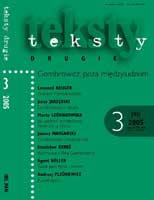Jak widzieć architekturę, kiedy się ją czyta (u Gombrowicza i innych modernistów)?
How To See Architecture (In Gombrowicz And Other Modernist Authors) When It Is Being Read?
Author(s): Marta LeśniakowskaSubject(s): Literary Texts
Published by: Instytut Badań Literackich Polskiej Akademii Nauk
Keywords: WITOLD GOMBROWICZ; ARCHITECTURE; HISTORY OF ART; ICONOGRAPHY
Summary/Abstract: This article is the first-ever analysis of Gombrowicz’s (and other modernist authors’) liaisons with architecture in the history of Witold Gombrowicz scholarship. The Author inspects into these issues from the standpoint of so-called critical history of art, which positions her paper also within the area of methodological issues and new trends in studies of arts. In her opinion, absence of questions regarding Gombrowicz’s connections with architecture, the topic being absent/precluded from literary scholars’ papers, has to be deemed a ‘significant omission’. The question about a ‘presence’ of architecture in Gombrowicz has been based on an assumption that any work of art offers a model for recognising something, an epistemology of some sort. Attempt has been made at replying to the question about the actual place of architecture in Gombrowicz’s aesthetic and/or ethical system, and about the role he has programmed for it in his texts. Gombrowicz was namely positioning architecture in the ‘zone of a subculture’, of ‘secondary forms’. In his concept of architecture as a secondary form, a structure of mythology and a repressive effect of the myth become revealed. Thus, architecture is perceived as a language, as a ‘meaningful’ fact, a narration that ‘projects’ the internal space, in line with the rules (cultural and iconographical) of permanence of pose and attribute. In Gombrowicz’s discourse, architecture as a representation becomes one of his masks, a crypto-text. This is how it might be ‘seen’ whilst being ‘read’, Ms. Leśniakowska concludes.
Journal: Teksty Drugie
- Issue Year: 2005
- Issue No: 3
- Page Range: 38-57
- Page Count: 20
- Language: Polish

